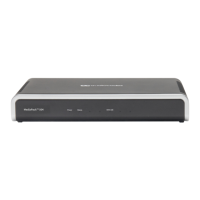SIP User's Manual 314 Document #: LTRT-65415
MediaPack Series
No-Op payload format for RTP. The draft defines the RTP payload type as dynamic.
You can control the payload type with which the No-Op packets are sent. This is
performed using the RTPNoOpPayloadType ini parameter (see ''Networking
Parameters'' on page 333). AudioCod
es’ default payload type is 120.
T.38 No-Op: T.38 No-Op packets are sent only while a T.38 session is activated. Sent
packets are a duplication of the previously sent frame (including duplication of the
sequence number).
Note: Receipt of No-Op packets is always supported.
9.3 IP Multicasting
The device supports IP Multicasting level 1 according to RFC 2236 (i.e., IGMP version 2)
for RTP channels. The device is capable of transmitting and receiving Multicast packets.
9.4 Robust Receipt of Media Streams
This mechanism filters out unwanted RTP streams that are sent to the same port number
on the device. These multiple RTP streams can result from traces of previous calls, call
control errors, and deliberate attacks. When more than one RTP stream reaches the
device on the same port number, the device accepts only one of the RTP streams and
rejects the rest of the streams.
The RTP stream is selected according to the following: The first packet arriving on a newly
opened channel sets the source IP address and UDP port from which further packets are
received. Thus, the source IP address and UDP port identify the currently accepted stream.
If a new packet arrives whose source IP address or UDP port are different to the currently
accepted RTP stream, one of the following occurs:
The device reverts to the new RTP stream when the new packet has a source IP
address and UDP port that are the same as the remote IP address and UDP port that
were stated during the opening of the channel.
The packet is dropped when the new packet has any other source IP address and
UDP port.
9.5 Multiple Routers Support
Multiple routers support is designed to assist the device when it operates in a multiple
routers network. The device learns the network topology by responding to Internet Control
Message Protocol (ICMP) redirections and caches them as routing rules (with expiration
time).
When a set of routers operating within the same subnet serve as devices to that network
and intercommunicate using a dynamic routing protocol, the routers can determine the
shortest path to a certain destination and signal the remote host the existence of the better
route. Using multiple router support, the device can utilize these router messages to
change its next hop and establish the best path.
Note: Multiple Routers support is an integral feature that doesn’t require
configuration.

